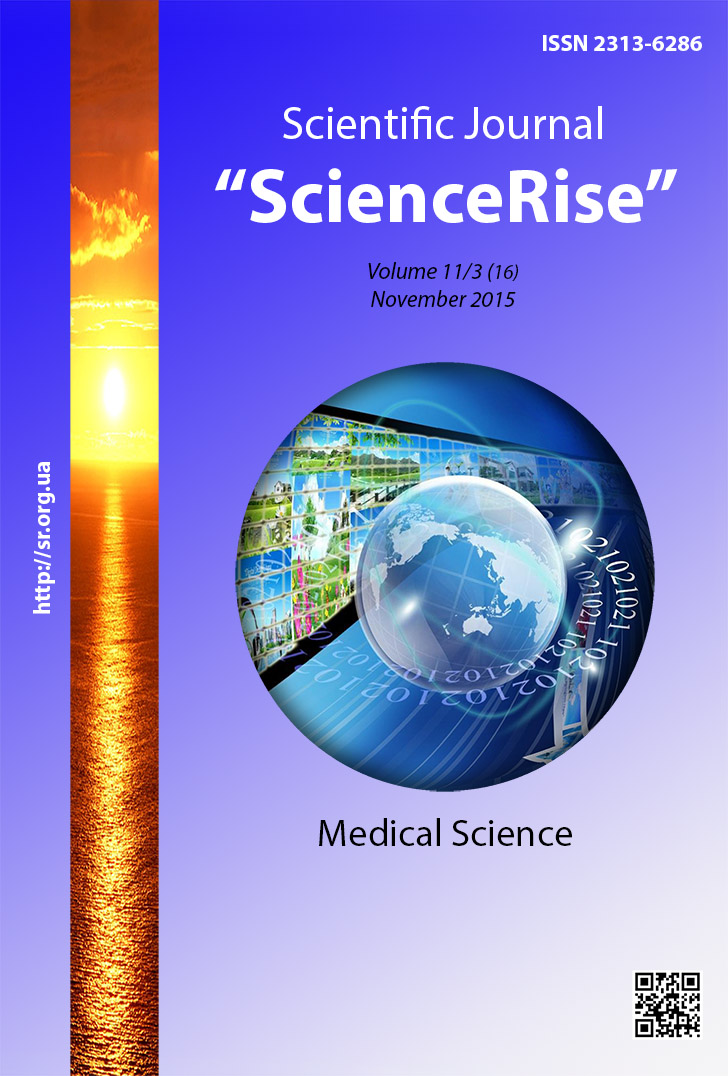The role of factors of the hemostasis system and fibrinolysis in the development of gastroesophageal reflux in patients with chronic obstructive pulmonary disease
DOI:
https://doi.org/10.15587/2313-8416.2015.53884Keywords:
chronic obstructive pulmonary disease, gastroesophageal reflux disease, hemostasis, fibrinolysis, hypercoagulationAbstract
Gastroesophageal reflux disease (GERD) and chronic obstructive pulmonary disease (COPD) belong to common pathological conditions comorbid in 25–60 % of cases.
Objective: to find probable mechanisms of GERD progressing against the ground of COPD by means of learning various links of the blood clotting system, anticoagulative blood activity and fibrinolysis for further improvement of the ways to correct the disorders found.
Methods. 124 patients with COPD were examined including 90 with comorbid GERD. The control group included 24 practically healthy individuals of an appropriate age and sex. Clinical, biochemical, instrumental and statistical methods of examination were applied.
Results. The patients were divided into the following groups: the 1st group – 34 patients with COPD, the 2nd group – 30 patients with COPD with endoscopically negative GERD, the 3rd group – 30 patients with COPD and endoscopically positive non-erosive GERD, the 4th group – 30 patients with COPD and endoscopically positive erosive GERD. The following results were found: while examining coagulation hemostasis – decrease of prothrombin time, fibrinogen content; while examining anticoagulation blood potential – decrease of thrombin time, activity of antithrombin III; while examining fibrinolytic blood activity – inhibition of the total fibrinolytic activity (at the expense of enzymatic activity decrease) and compensatory increase of non-enzymatic fibrinolytic activity, decrease of Hageman-dependent fibrinolysis activity.
Conclusions. Disorders of coagulation hemostasis, anti-coagulation potential and fibrinolytic blood activity are intensified with the increase of severity of bronchial obstructive syndrome and promote the development of endoscopically positive erosive GERD
References
Oparin, A. G., Oparin, A. A., Titkova, A. V. (2013). Vlijanie soputstvujushhej gastrojezofageal'noj refljuksnoj bolezni na klinicheskoe techenie i funkciju vneshnego dyhanija u bol'nyh hronicheskim obstruktivnym zabolevaniem legkih. Gastroenterologіja, 3 (49), 46–49.
Ostrovs'kyj, M. M., Herych, P. R. (2011). Do pytannia polimorbidnosti ta komorbidnosti u khvorykh na KhOZL. Ukr. pul'monol. zhurn., 4, 19–24.
Fadeenko, G. D., Kamenir, V. M. (2010). Dinamika klinicheskih projavlenij u pacientov s gastrojezofageal'noj refljuksnoj bolezn'ju v sochetanii s hronicheskim obstruktivnym zabolevaniem legkih na fone lechenija melatoninom. Suchasna gastroenterologija, 3 (53), 18–24.
Titkova, A. V. (2013). Kliniko-funkcional'nye i immunovospalitel'nye osobennosti sochetannogo techenija hronicheskogo obstruktivnogo zabolevanija legkih i gastrojezofageal'noj refljuksnoj bolezni i ih korrekcija. Medicina s'ogodnі і zavtra, 1 (58), 81–85.
Fass, R. (2003). Epidemiology and pathophysiology of symptomatic gastroesophageal reflux disease. American Journal of Gastroenterology, 98 (3s), S2–S7. doi: 10.1016/s0002-9270(03)00009-1
Heading, R. C. (1999). Prevalence of upper gastrointestinal symptoms in the general population: a systematic review. Scand. J. Gastroenterol. Suppl., 231, 3–8.
Babak, O. Ja. (2014). Gastrojezofageal'naja refljuksnaja bolezn'. Ot teorii k praktike. Suchasna gastroenterol., 4 (78), 38–44.
Lazebnik, L. B., Masharova, A. A., Bordin, D. S. et. al (2011). Rezul'taty mnogocentrovogo issledovanija «Jepidemiologija gastrojezofageal'noj refljuksnoj bolezni v Rossii («MJeGRE»). Ter. arhiv, 1, 45–50.
Vasil'ev, Ju. V.; Lazebnyk, L. B. (Ed.) (2011). Gastrojezofageal'naja refljuksnaja bolezn'. Moscow: Planida, 24.
Babak, M. O. (2011). Poshyrenist' typovykh ta atypovykh proiaviv hastroezofaheal'noi refliuksnoi khvoroby. Ukr. ter. zhurn., 2, 33–37.
Babak, O. Ja., Fadeenko, G. D. (2000). Gastrojezofageal'naja refljuksnaja bolezn'. Kyiv: Interfarma, 175.
Yartseva, S. V. (2005). Hemoreolohichni porushennia u khvorykh na khronichne obstruktyvne zakhvoriuvannia lehen', spoluchene z ishemichnoiu khvoroboiu sertsia, ta ikh korektsiia. Lugansk, 27.
Tic, N.; Menshikov, V. V. (Ed.) (1997). Jenciklopedija klinicheskih laboratornyh testov. Moscow: Labinform, 960.
Ljah, Ju. E., Gur'janov, V. G., Homenko, V. N. et. al (2006). Osnovy komp'juternoj biostatistiki: analiz informacii v biologii, medicine i farmacii statisticheskim paketom MedStat. Doneck: Papakica E. K., 214.
Pylypenko, M. I., Radzishevs'ka, Ye. B., Knyhavko, V. H. (2001). Lektsii z matematychnoi statystyky dlia likariv. Kharkiv, 88.
Tillie-Leblond, I., Marquette, C. H., Perez, T. et. al (2006). Pulmonary embolism in patients with unexplained exacerbation of chronic obstructive pulmonary disease: prevalence and risk factors. Annals of Internal Medicine, 144 (6), 390–396. doi: 10.7326/0003-4819-144-6-200603210-00005
Downloads
Published
Issue
Section
License
Copyright (c) 2015 Інна Володимирівна Дудка

This work is licensed under a Creative Commons Attribution 4.0 International License.
Our journal abides by the Creative Commons CC BY copyright rights and permissions for open access journals.
Authors, who are published in this journal, agree to the following conditions:
1. The authors reserve the right to authorship of the work and pass the first publication right of this work to the journal under the terms of a Creative Commons CC BY, which allows others to freely distribute the published research with the obligatory reference to the authors of the original work and the first publication of the work in this journal.
2. The authors have the right to conclude separate supplement agreements that relate to non-exclusive work distribution in the form in which it has been published by the journal (for example, to upload the work to the online storage of the journal or publish it as part of a monograph), provided that the reference to the first publication of the work in this journal is included.

